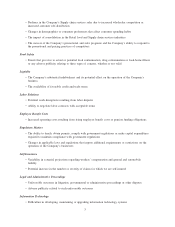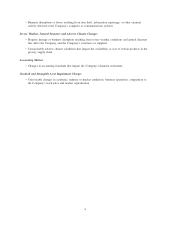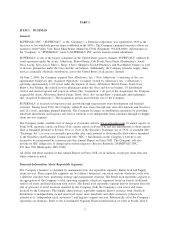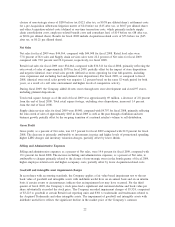Albertsons 2010 Annual Report Download - page 19
Download and view the complete annual report
Please find page 19 of the 2010 Albertsons annual report below. You can navigate through the pages in the report by either clicking on the pages listed below, or by using the keyword search tool below to find specific information within the annual report.or severity of claims for which the Company is self-insured increases, or the Company is required to accrue or
pay additional amounts because the claims prove to be more severe than the Company’s original assessments,
the Company’s financial condition and results of operations may be adversely affected.
Litigation
The Company’s businesses are subject to the risk of litigation by employees, consumers, suppliers, stockhold-
ers or others through private actions, class actions, administrative proceedings, regulatory actions or other
litigation. The outcome of litigation, particularly class action lawsuits and regulatory actions, is difficult to
assess or quantify. Plaintiffs in these types of lawsuits may seek recovery of very large or indeterminate
amounts, and the magnitude of the potential loss relating to such lawsuits may remain unknown for substantial
periods of time. The cost to defend future litigation may be significant. There may also be adverse publicity
associated with litigation that may decrease consumer confidence in the Company’s businesses, regardless of
whether the allegations are valid or whether the Company is ultimately found liable. As a result, litigation may
adversely affect the Company’s financial condition and results of operations.
Information technology systems
The Company has complex information technology systems that are important to the operation of its
businesses. The Company may encounter difficulties in developing new systems or maintaining and upgrading
existing systems. Such difficulties may lead to significant expenses or losses due to disruption in business
operations and, as a result, may adversely affect the Company’s results of operations.
Additionally, data theft, information espionage or other criminal activity directed at the grocery or drug store
industry, the transportation industry, or computer or communications systems may adversely affect the
Company’s businesses by causing the Company to implement costly security measures in recognition of actual
or potential threats, by requiring the Company to expend significant time and expense developing, maintaining
or upgrading its information technology systems and by causing the Company to incur significant costs to
reimburse third parties for damages. Such activities may also adversely affect the Company’s financial
condition and results of operations by reducing consumer confidence in the marketplace and by modifying
consumer spending habits.
Weather and natural disasters
Severe weather conditions such as hurricanes, earthquakes or tornadoes, as well as other natural disasters, in
areas in which the Company has stores or distribution facilities or from which the Company obtains products
may cause physical damage to the Company’s properties, closure of one or more of the Company’s stores or
distribution facilities, lack of an adequate work force in a market, temporary disruption in the supply of
products, disruption in the transport of goods, delays in the delivery of goods to the Company’s distribution
centers or stores and a reduction in the availability of products in the Company’s stores. In addition, adverse
climate conditions and adverse weather patterns, such as drought or flood, that impact growing conditions and
the quantity and quality of crops yielded by food producers may adversely affect the availability or cost of
certain products within the grocery supply chain. Any of these factors may disrupt the Company’s businesses
and adversely affect the Company’s financial condition and results of operations.
Changes in accounting standards
Accounting principles generally accepted in the Unites States of America (“accounting standards”) and
interpretations by various governing bodies, including the SEC, for many aspects of the Company’s business,
such as accounting for insurance and self-insurance, inventories, goodwill and intangible assets, store closures,
leases, income taxes and stock-based compensation, are complex and involve subjective judgments. Changes
in these rules or their interpretation may significantly change or add significant volatility to the Company’s
13
























